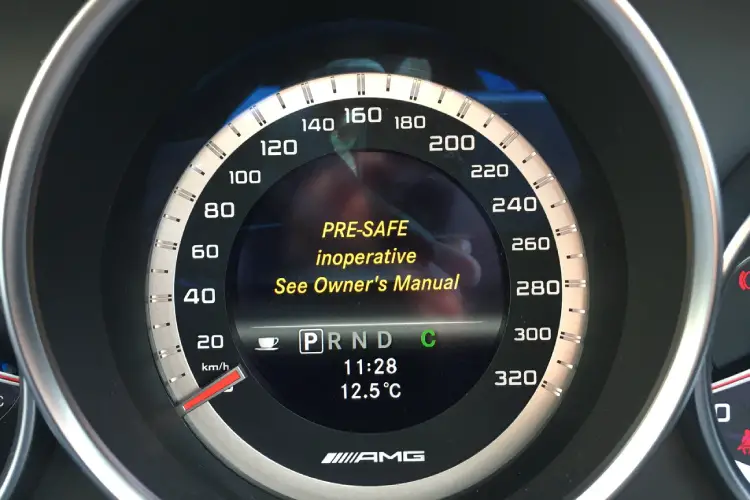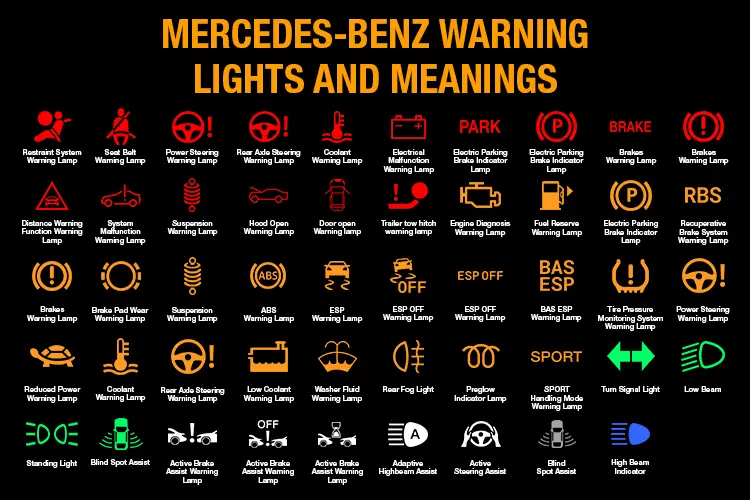Is the “Pre Safe Inoperative” alert on your Mercedes-Benz causing concern?
In this article, I will explain its meaning, possible causes, and guide you on how to reset the message.
Let’s get started!
What Is the Pre Safe System in Mercedes-Benz?
Mercedes-Benz’s Pre-Safe system is designed to detect possible crashes and prepare the car for impact.
It uses sensors to monitor the driving environment. When they detect a likely collision scenario, the system springs into action:
- Adjusting seat positions
- Automatically tightening seat belts
- Closing open windows and the sunroof.
This adds an extra layer of safety during accidents.
What Does the “Pre Safe Inoperative” Message Mean?

The “Pre Safe Inoperative” message indicates a problem with the Pre-Safe system in your Mercedes-Benz vehicle. While primary safety features such as airbags and brakes will remain functional, the additional protective measures offered by the Pre-Safe system may not be operational.
Though you can continue driving with this message displayed, be cautious and seek a resolution to the issue promptly. For precise diagnostics, I recommend using a Mercedes-specific scanner, ensuring a more streamlined repair process.
Moreover, always stay informed about any official recalls or updates from Mercedes-Benz related to this system.
What Could Cause the “Pre Safe Inoperative” Message to Appear?
Sensor Issues
The Pre-Safe system relies on various sensors to detect and prepare for potential collisions:
- Radar Sensors: Located at the front and rear bumpers, they detect nearby objects or vehicles.
- Stereo Multi-Purpose Camera (SMPC): Positioned behind the windshield near the rearview mirror, it captures a 3D view of the front area.
- Lateral Acceleration Sensors: Distributed within the chassis, they detect side-to-side movements.
- Yaw Rate Sensor: Found within central electronics, it measures the vehicle’s rotational rate.
- Seat Occupancy Sensors: Embedded in the seats, they identify if a seat is occupied.
Any issues with these sensors, whether from wear and tear or external factors like dirt and debris, can cause the system to become inoperative.
A common sign of sensor issues is the appearance of the “Radar sensors dirty” message, or the simultaneous activation of the ABS, brake, and traction control lights.
Battery Voltage
The Pre-Safe system requires a stable power supply to function properly. A weak battery or irregular voltage can compromise the system’s ability to operate efficiently.
Electrical Problems
The system’s functionality depends on its intricate electrical connections. Wiring issues, shorts, or disconnected components can disrupt its operations.
Malfunctioning Restraint System Control Unit
This unit manages the passive safety features, such as airbags and seatbelt pretensioners. If this control unit malfunctions, the Pre-Safe system might not work as intended.
Faulty Seatbelt Buckle Switches
These switches detect if seatbelts are buckled. Issues with these switches can lead the system to believe seatbelts aren’t fastened, triggering the “Pre safe inoperative” message.
How to Reset the “Pre Safe Inoperative” Message?
Step 1: Pull Over and Restart the Vehicle
Find a safe spot to pull over. Turn off the car, wait a moment, then restart it. Sometimes, this simple reset can clear transient system errors.
Step 2: Check the Battery Voltage
Ensure the battery is in good health and fully charged. A low battery or inconsistent voltage can affect the Pre-Safe system’s functionality.
Step 3: Scan for Error Codes
Connect an OBD scanner to your vehicle’s diagnostic port. This tool will retrieve any fault codes stored in the car’s computer, providing specific clues about which component is causing the error.
Step 4: Inspect and Rectify Based on Diagnostic Results
- Examine all sensors related to the Pre-Safe system. Check for obstructions, dirt, or physical damage. Gently clean them with a soft cloth if necessary.
- Evaluate the wiring and electrical connectors associated with the system. Look for obvious signs of wear, disconnections, or potential shorts.
- Inspect both the seat belt module and buckle switches. Ensure they function correctly and aren’t obstructed or damaged.
Step 5: Clear Error Codes and Update Software
Once repairs are complete, use the OBD scanner to clear any error codes.
Check with your Mercedes-Benz dealer or the official website to determine if there’s a software update available for your vehicle’s Pre-Safe system. Apply the update if necessary.
What’s Next?
We hope this guide provides clarity on the ‘Pre Safe Inoperative’ alert and its implications for your Mercedes-Benz.
If you’ve faced this issue or have additional insights, please share your experiences in the comments below—we value your input!



Recommended for you
Auxiliary Battery Malfunction Mercedes: 5 Causes and How to Fix It
“Radar Sensors Dirty” on Mercedes: What You Need to Know
Mercedes-Benz Warning Lights and Meaning